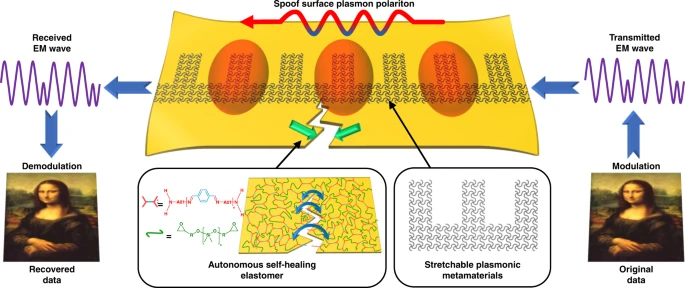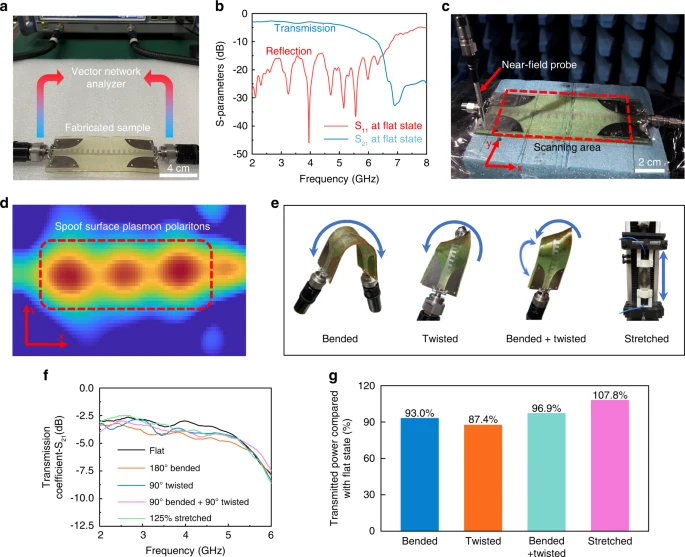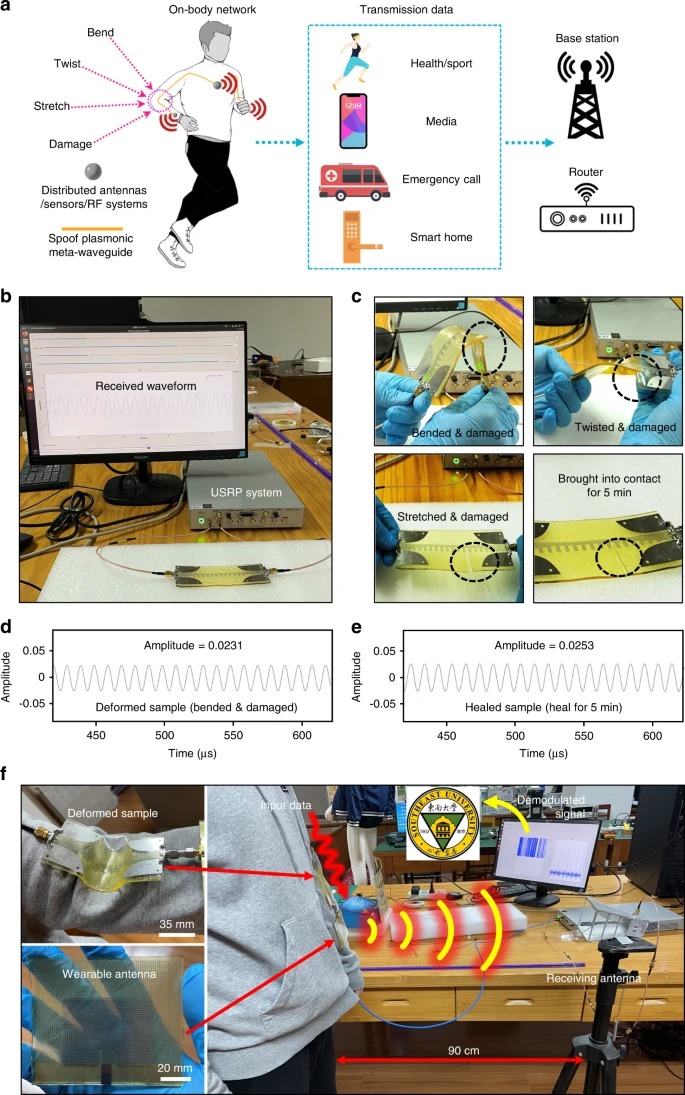A team of researchers recently published a paper in the journal Light: Science & Applications that demonstrated a novel strategy to fabricate stretchable microwave transmission lines with superior durability and reliability for wearable wireless communication systems.

Study: Stretchable and self-healable spoof plasmonic meta-waveguide for wearable wireless communication system. Image Credit: Ground Picture/Shutterstock.com
Background
Stretchable and flexible microwave devices, which are an integral part of wireless communication systems, play a crucial role in wearable wireless communication systems, including biomedical equipment and electronic skins.
However, the metallic structures and elastic substrates of stretchable microwave devices are damaged easily after multiple deformations, leading to severe degradation in the performance of these devices as their electromagnetic properties are influenced by structural changes.
Even minor structural damage in microwave transmission lines can significantly reduce their transmission efficiency. Thus, structural damage that occurs in microwave transmission lines due to frequent stretching, twisting, and bending during long-term use significantly affects the stability of wireless communication systems.
The conventional metallic structural design and elastic substrates are ineffective in addressing this issue. Self-healing materials are considered a suitable alternative to improve the durability and reliability of stretchable microwave transmission lines. Self-healable polymer materials can overcome the problem of permanent performance degradation as they can autonomously repair themselves after mechanical damage.
However, the fabrication of a self-healable microwave transmission line with good mechanical strength, autonomous self-healing ability, and proper dielectric properties, which are crucial for good reliability and performance of microwave devices, is extremely difficult.
Moreover, the use of self-healable conducting composites in microwave transmission lines is considerably challenging in conductive structure design owing to their poor stability and low electrical conductivity compared to common metals.
Although mechanically stretchable metallic structures possess good reliability and electrical conductivity, the integration between the elastic substrate and metallic structures is difficult. These structures cannot repair themselves after damage due to a lack of self-healing ability.

Conceptual illustration of the stretchable and self-healable spoof plasmonic meta-waveguide. Self-healing material enhances structural strength and durability, while the SSPP structure improves reliability and gives more tolerance to the self-healing process. Image Credit: Li, Q et al., Light: Science & Applications
The Study
In this study, researchers proposed a novel strategy to synthesize stretchable microwave transmission lines with superior durability and reliability by integrating self-healable elastomer with specially designed serpentine geometry plasmonic meta-waveguide to support the spoof surface plasmon polaritons (SSPPs).
The self-healable elastomer was designed and synthesized as a microwave substrate based on an epoxy-polyimine covalent adaptive network (CAN). The serpentine geometry strategy was innovatively introduced into the plasmonic meta-waveguide to support the SSPP propagation.
Terephthalaldehyde (TPA), toluene and molecular sieves, 1,3-bis(3-aminopropyl)-1,1,3,3-tetramethyldisiloxane (A01), benzyl glycidyl ether, EcofelxTM 00-30, and epoxypropoxypropyl terminated polydimethylloxane were used as the starting materials.
Initially, the dynamic imine oligomer as an epoxy-curing agent (A01-TPA) was synthesized, followed by the synthesis of the self-healing substrate. Epoxypropoxypropyl terminated polydimethylsiloxane and benzyl glycidyl ether were mixed at 2400 rpm using a speed mixer, and the resultant epoxy mixture was designated as EP.
A01-TPA and EP were then mixed thoroughly and degassed at 2400 rpm using a speed mixer. Subsequently, the bubble-free mixture was poured into a 150 mm × 100 mm × 2 mm polytetrafluoroethylene (PTFE) mold and then cured for four h at 80 oC in an air oven. A yellow transparent film (ATPA-EP) was finally obtained after peeling off from the PTFE mold, which was used as the self-healing substrate.
Proton nuclear magnetic resonance spectroscopy, Fourier transform infrared spectroscopy, thermal gravimetric analysis, differential scanning calorimetry, X-ray diffraction, and gel permeation chromatography were performed to characterize the synthesized samples.
Researchers performed mechanical tests, rheological tests, and self-healing tests. Additionally, electromagnetic characteristics and adhesion of the self-healing ATPA-EP substrate were measured using a split post-dielectric resonator and performing lap-shear strength tests, respectively. The electromagnetic and communication performance of the SSPP spoof plasmonic meta-waveguide were also evaluated.

Measurement of the undamaged spoof plasmonic meta-waveguide. a Experimental photograph of the meta-waveguide in the flat state. b Measured S-parameters of the flat sample. c Near-field distribution measurement of the meta-waveguide. d Measured near-field distributions of the meta-waveguide. e Experimental photograph of the meta-waveguide with different deformed state. f Measured transmission coefficients and g power comparison of the deformed samples. Image Credit: Li, Q et al., Light: Science & Applications
Observations
A stretchable and self-healable spoof plasmonic meta-waveguide was fabricated successfully by integrating serpentine-geometry plasmonic metamaterials and self-healable elastomer. An epoxy-polyimine CAN/ATPA-EP was synthesized as a self-healing and stretchable substrate.
The metallic structure and the elastic substrate were tightly bonded together without any equipment or adhesive due to the robust interaction between the metal surface and the epoxy group, facilitating the fabrication process.
The optimized ATPA-EP/epoxy-polyimine CAN displayed greater material strength, good dielectric properties, and autonomous self-healing ability. Additionally, the plasmonic meta-waveguide displayed exceptional stability and stretchability with a good electromagnetic performance due to its serpentine geometry.
The fabricated spoof plasmonic meta-waveguide showed stable electromagnetic performance under complex and extreme deformation. The meta-waveguide maintained stable performance and mechanical strength when the metallic structure and the substrate were partially damaged due to the unique field distributions of SSPPs.
Moreover, the meta-waveguide maintained reliable performance even when the self-healing process or the repair effect was incomplete. The self-healing material improved the structural durability and strength, while the SSPPs improved the stability and tolerance required for the self-healing process.

Communication performance of the spoof plasmonic meta-waveguide. a Conceptual illustration of the body area network based on the spoof plasmonic meta-waveguide. b Measurement setup of the waveform transmission experiment. c Photos of the damaged and deformed meta-waveguide. d Received waveform of the bend and damaged sample. e Received waveform of the healed sample. f On-body wireless communication experiment of the spoof plasmonic meta-waveguide with the help of the USRP system and wearable antenna. Image Credit: Li, Q et al., Light: Science & Applications
No significant reduction was observed in the transmission efficiency of healed meta-waveguide after the autonomous healing process. The healing efficiency was 95.3% after 24 h of autonomous healing at room temperature.
Communication quality experiments displayed the potential of the proposed meta-waveguide as interconnects in future body area network systems. Thus, the proposed fabrication strategy coordinated the structural design with material fabrication to maximize the advantages of self-healing material and SSPP to increase the stability of microwave transmission lines significantly.
To summarize, the findings of this study demonstrated the feasibility of using the proposed low-cost self-healable and stretchable spoof plasmonic meta-waveguide with excellent damage resistance, strong stability, and autonomous self-healing characteristics in wearable wireless communication systems, such as wearable medical devices.
Disclaimer: The views expressed here are those of the author expressed in their private capacity and do not necessarily represent the views of AZoM.com Limited T/A AZoNetwork the owner and operator of this website. This disclaimer forms part of the Terms and conditions of use of this website.
Source:
Li, Q., Ding, C., Ju, L. et al. Stretchable and self-healable spoof plasmonic meta-waveguide for wearable wireless communication system. Light: Science & Applications 2022. https://www.nature.com/articles/s41377-022-01005-1